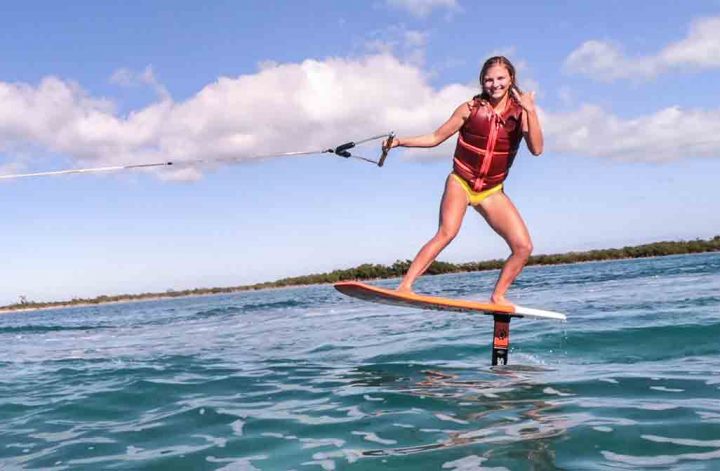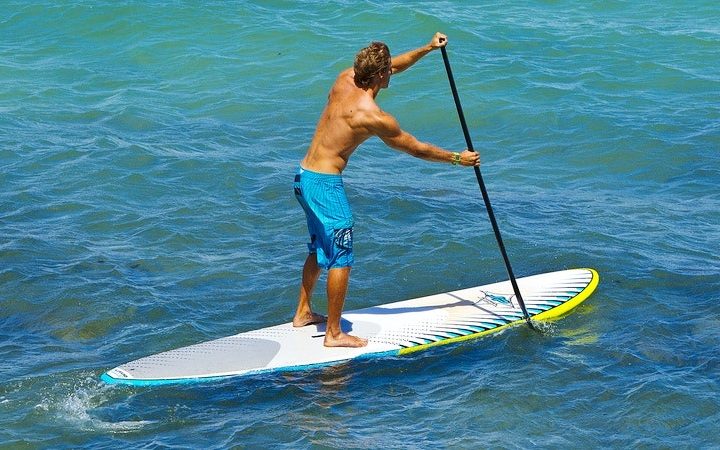So, you’ve had a few lessons or borrowed your mate’s board enough times to know you want to buy your very own surfboard. Heck yeah, exciting times!
But where to start? With so many shapes and sizes it’s hard to know which surfboard is best when you’re starting out. Don’t worry, we’re here to help. This article recommends a surfboard to you based on a few different factors – how often you intend to surf, where you surf and if you travel a lot. Ok, here goes.
Volume is everything. Well, almost. Choosing a good beginner surfboard is mostly to do with making sure it has plenty of volume. The volume of your board is a measurement of the total amount of space that your board occupies. Lots of volume in a board will make it float better and – for someone learning – it makes it easier to get up and catch your first wave.
A common beginner’s mistake when buying your first surfboard is getting one with too little volume. Soft surfboards, longboards, minimals and magic carpets have lots of volume. Fish surfboards and shortboards have less.
Volume is measured in litres. A good beginner board has 60+ litres in volume – the more the better. A minimal to longboard size surfboard could be around 65-80 litres. Compare this to a performance shortboard that someone like pro-surfer Kelly Slater might ride (like a 6’1 x 18 ¼ inch shortboard) would only have around 24 litres in volume. To master a board that small you’ll need to have a pretty developed technique – plus you’ll need to find the right waves.
As a beginner it’s ideal to be able to surf in pretty much all conditions – first in the white water and then catching unbroken ‘green’ waves. A surfboard that will help you achieve this is one with plenty of volume. So remember: when you’re starting out, volume is your friend.
Other factors to consider when picking a beginner surfboard can include durability; as you learn you may knock your board around a bit. Another practical consideration might be ‘will it fit in my car?’. Food for thought.
Now, let’s look at the main types of surfboards and some pros and cons of each.
Soft Surfboards | Length 7ft – 9ft
Pros
- Reasonably cheap to buy
- Safer than a hard board if it hits you in the surf
- You can surf white-water
- Easy to catch most waves
- Great if you only intend to surf a handful of times each year
- Single fin or 3 fin thrusters available as well as smaller twin fin models
Cons
- Can be quite bulky and heavy
- A 9ft board won’t fit inside most cars so you’ll need to put it on the roof
- Can absorb a lot of water if you do have them inside car
- Not much cheaper than hard surfboards
- Not ideal for surfing over shoulder-high waves
- Can be difficult to paddle out on when surf gets bigger
Notes:
Popular brands for softboards include: FCS and Gnaraloo. Soft surfboards are typically available in 6 and 7ft versions (for kids) up to the 8 and 9ft models. 8ft long would be the smallest length a regular adult should learn on.
Epoxy Longboards or Fibreglass PU | Length 8ft – 9ft+
Pros
- Can be faster and more manoeuvrable than soft surfboards
- You can learn to do longboard moves – like cross stepping or hanging 5
- Will perform better in head-high waves (if you can paddle out)
- Should hold its value fairly well if you decide to sell or upgrade
Cons
- A longer board means it won’t fit inside most cars if it’s over 8ft
- Bulky and heavy to carry
- It will hurt more than a soft surfboard if it hits you
- Can be more difficult to catch waves than a softboard
- Performs better on unbroken ‘green’ waves
Notes
Entry-level brands that sell tough beginner friendly longboards include: NSP and Modern. Also note, a standard Fibreglass (PU) surfboard won’t be as tough and forgiving to knocks or dings as most Epoxy surfboards.
Mini Mal Surfboards | Length 7’4 – 8’0
Pros
- A slightly smaller board makes it easier to carry
- A 7’6 mini mal can fit in a smallish hatchback (if the passenger seat is empty)
- Easier to paddle out in bigger surf than a large soft surfboard
- Likely to progress your surfing a little faster and improve paddle fitness
- Epoxy versions can be very durable and retain a good resale value
Cons
- Harder to catch waves than a longboard or softboard
- They are not soft so avoid the board hitting you where possible
- A mini mal is still quite large so it can be difficult to get back out past head-high waves
- Cheaper models can sometimes still be tricky to turn
- Not as fast as smaller surfboards
Notes:
Popular brands for beginner mini mals are NSP and Creative Army. They are made from Epoxy so are very durable and keep their value well.
Magic Carpet Surfboards | Length 6’10 – 7’2
Pros
- Similar to mini mals a magic carpet surfboards are a small version of the longboard with the middle 2 feet taken out
- Single fin and thruster options available
- Lighter and easier to carry than large longboards and softboards
- Slightly smaller than mini mals these boards can be faster and a little easier to paddle out back around bigger surf
- A Magic Carpet will surf in small knee high waves to overhead high surf
- Progressive enough that you could carry on surfing this type of board for a long time
- Small enough to fit in most cars
Cons
- Less volume than a longboard so requires more effort to catch waves
- Can be a more challenging board to learn on for complete beginners than a longboard
- Non Epoxy versions will be more susceptible to dings and breakage
- These surfboards have quite a wide nose design which means if waves get steep or very choppy care must be taken to avoid sinking the nose
- Whilst smaller than longboards, magic carpets are not as fast or as maneuverable as shortboards, and still have quite a big turning radius
Notes:
There are some good magic carpet style boards out there in both single fin and thruster 3-fin options – the NinePlus and MG surfboards seem particularly popular. These surfboards are able to catch very small unbroken waves and can still handle overhead waves. Whilst they do not have as much volume as a longboard (and require more effort to paddle onto a wave) they can be a more practical option if you want to fit your board inside a small car.
Large Fish Surfboard: Length 6’4 +
Pros
- Fast and easier to turn than longer boards
- Lightweight and easier to carry
- Will fit into most cars easily
- Easier to duck dive out in bigger surf
- Epoxy versions are very durable
- Low cost options available
- Tri (3) fin thruster and quad versions are available
Cons
- Harder to catch waves: beginners will spend less time surfing and more time paddling
- Beginners benefit from surfing small waves – shortboards are mainly designed for surfing bigger waves (chest to head-high)
- Ability to catch unbroken green waves necessary to get the most out of a shortboard, as they are not designed to catch white water
- Overall, this is not the obvious choice for a beginner (however cool they look!)
- Can have weaker resale value compared to some of the other boards
Notes:
It’s important to note that big shortboards are not big purely because of their length, but also because of their width too. Big shortboards will often be at least 20 inches or more wide. Well known models are made by brands like Gerry Lopez, NSP and Modern.
In Conclusion
In conclusion, your own taste will come into play a lot when buying your first surfboard. You may already have a style or brand you like, or have tried a certain size before and think it suits you well. But for someone looking for a general steer here is a rule of thumb you can use as a guide:
I intend to surf 1-2 days a year: Soft Surfboard
I intend to surf about 5-7 days a year: Soft Surfboard, Longboard, Mini Mal
I intend to surf at least once a month: Longboard, Mini Mal, Magic Carpet
I intend to surf a few days a month: Longboard, Mini Mal, Magic Carpet or Fish
I intend to surf every week: Longboard, Mini Mal, Magic Carpet, Fish or Big Shortboard
Talk to the experts! Underground Surf has over 20 years of experience matching people to the right board. If you’re not sure where to begin, give us a ring or even better come by our Orewa shop and we can help find your first board.



